A Scarecrow Empire
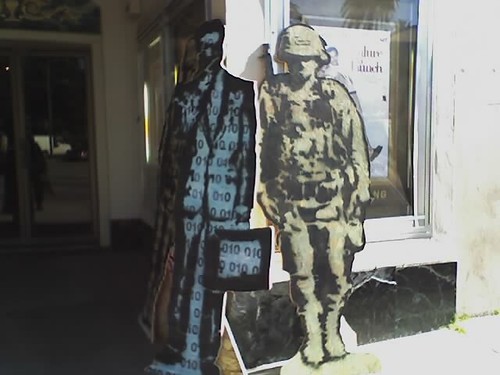
[Image: Via Brick House.]
Central to the effectiveness of any form of security is its ability to project power and to exponentialize its apparent sphere of influence beyond the verifiable boundaries of its control; to dupe people, essentially. Territory – as a material of power – succeeds in part not only because it marks its authority with definite radius but also its ability to transcend that same demarcation through a more fluid and illusory expansion of the imagination that defies the scrutiny of formal measure. Power, as a phenomenon, is as much a colonizer of the psychological landscape as it a producer or a product of the built environment. I mean, that’s one aspect, anyway – power’s ability to endure based on assumption, deception, and its occupation of the mind.
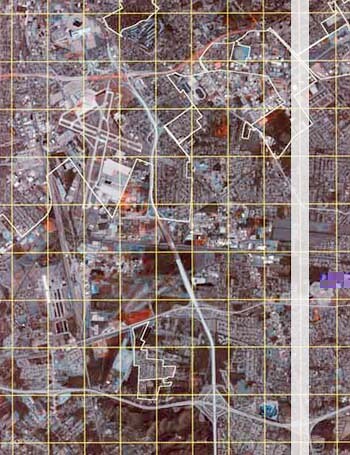
[Image: Via CTRLSTRG.]
As you know, the parameters of sovereign power aren’t simply a matter of coordinates on a map, recorded border geographies, or security zones strategically linked over a grid, but are a striation of imaginary longitudes and latitudes that more abstractly territorialize an insinuation of “evil” and “threat” through the making of culture, which helps in turn to justify the constitution of power’s alleged means for interdicting “evil” well within and beyond its own borders.

In the opening of his book The Colonial Present
These are constructions that fold distance into difference through a series of spatializations. They work, Said argued, by multiplying partitions and enclosures that serve to demarcate “the same” from “the other,” at once constructing and calibrating a gap between the two by “designating in one’s mind a familiar space which is ‘ours’ and an unfamiliar space beyond ‘ours’ which is ‘theirs’. ‘Their’ space is often seen as the inverse of ‘our’ space’: a sort of negative, in the photographic sense that ‘they’ might develop into something like “us,” but also the site of an absence, because “they” are seen to lack the positive tonalities that supposedly distinguish “us”. We might think of imaginative geographies as fabrications, a word that usefully combines “something fictionalized” and “something made real,” because they are imaginations given substance.
An idea you undoubtedly are familiar with already, but which also makes more obvious the notion that power is often exercised because its authority is unchecked and taken completely for granted, as it is a kind of ethos that populates thought, and in this sense it is the invisibility of the border that wields tremendous influence here, the dissolution of it; the border’s internalization and exportation beyond the site of the border itself and as anything but structurally visible. I guess in simpler terms, the point here is that a border often exists only because the public believes it does, and that is usually enough to contain or deter them.

[Image: Via The Subversion.]
Forgive my pseudo-academic rambling and redundant thought here, but as much as power is real and exists, it’s largely propped by this public consent that accepts power extends well into domains perhaps where it actually does not, and by a subsequent fear of consequences that come with transgressing such imaginary borders; because (and this isn’t groundbreaking psychology here) people—theoretically—are probably more easily controlled by the forces of what they don’t know and understand than by those they do, hence the richly cultivated ‘culture of fear’ that is so constitutive of American culture and makes for such an insightful and telling companion to neoliberal democracy. I guess I am just completely intrigued on an epistemological level by the cognitive development of that unconscious subservience to power that we all develop at some point that the larger forces of societal control largely depends on for its stability. To what degree we are trained to test power versus being shown to give into it, and how that plays out collectively in the form of organized community.

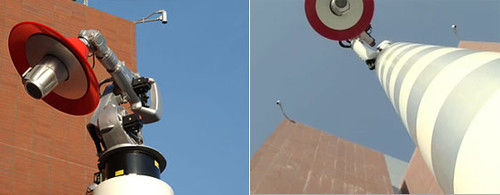
[Image: mojo robot project in san pedro, california, 2007, by christian moeller.]
It’s an ancient paradigm: for as visible as power likes and needs to make itself it also functions on a persistence of the unknown, as an act of imagination, and any spatial dimensions of it are (by and large, you could say), just a great scam that the general public willingly gives into—an Orwellian Oz works of smoke and mirrors.

[Image: NOPD Tower, Via Editor B.]
The performance of today’s wannabe omniscient panoptic urbanism with its millions of surveillance cameras stationed around the world, hinges on the same premise as those early symbols of power which have always dominated architecture from the Greek and Roman monuments of empire to the Catholic Cross, the Nazi swastika, to Saddam Hussein’s constant figurehead once seen in the streets of Baghdad everywhere.

The CCTV camera seems now to have absorbed and fulfilled the latest incarnation of this same tool of power in relation to architecture. The essence of which, however, rests on a similar collateral assumption: that people are perhaps more prone to being governed by the limits of power they fail to test than by those they successfully do, and are mostly made powerless by the disservice of their own imaginations, or lack thereof; a failure of autonomy.
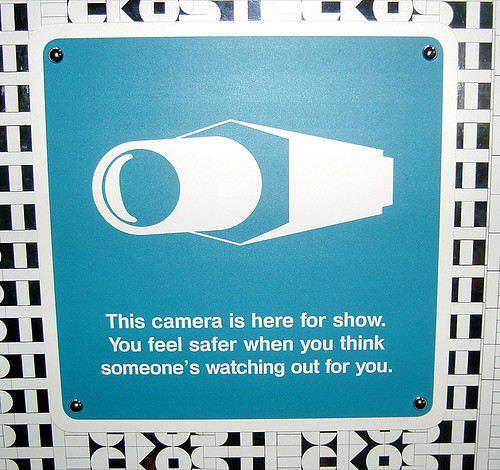
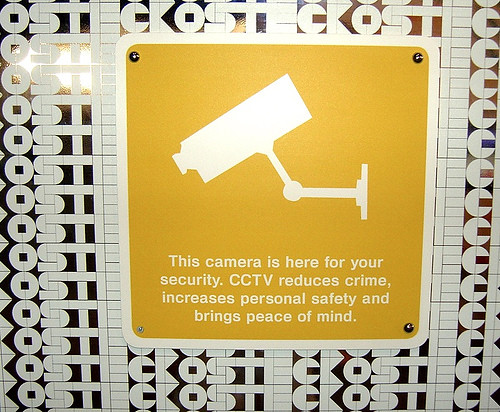

[Images: Via Ben Terrett.]
This is surely a very obtuse way of saying something incredibly basic, I know, but I never stop finding it curious: the simplest ways in which institutional power is so easily able to derive itself by piggybacking on its own kind of void; that power is (in essence) someway the absence of itself, and how authority rests on a perpetual mythology that is commonly understood and accepted as truth which then fixes power to space. Perhaps on some level power is inscribed spatially merely by one’s belief in the ventriloquist theatrics of its masterful reverberative impostorship, and so along those lines I’m curious how architecture (or built space, in general) guides people to buy into the hollow clones of power; how architecture is power’s impostor, or its indelible stooge. Is it not the very submission to the limited ideas of space rather than the walls themselves that brings power and powerlessness into existence?
I don’t know, occasionally I get stuck in the middle of the street taking in everything around me, how it all abides by the evolution of a set of rules that have physically left their history in the morphology of the city. How the city is the constant folding of space into rule, into spatial and social order; space made to impose rule over us. Rules as the atomic structure of the city. I don’t know. A city today organized by logics of paranoia and securitization; the city enslaved to barrier, and so forth. Or, maybe in the words of Lebbeus Woods:
“the old cities were heterarchies made up of complex layers of buildings and open spaces, of uses and reuses, woven over centuries and generations into a living tissue of meanings, the old cities absorbed into the complexity the hierarchies that governed them, that attempted to force their life into rigid structures they had never been, and could never be.”
I can’t help noticing the city with all of its new battle gear and anti-terrorist accoutrement as being caught up in a giant foolish pose, an insidious and frankly embarrassing masquerade of security, like a colossal structural bouncer, cluttered with objects doing their best to avert my attention, or derail my curiosity, or just cast their gaze on me and make me feel exposed. Nearly every object and dimension of the city has been, as Micheal Sorkin phrases it, “deputized” in order to serve a dual purpose – from decorative functional object to a barrier against possible threat. Everything has got a double life as a security agent these days. It’s the city pretending to be both transparent and bulletproof at the same time, while it’s really hardly neither. I mean, at this point, the “terrorists” have completely succeeded and would not even need to strike any more because American society has already adopted a posture that lives in a constant state of terror. Bruce Schneier made this point bluntly but elegantly not too long ago:
“The point of terrorism is to cause terror, sometimes to further a political goal and sometimes out of sheer hatred. The people terrorists kill are not the targets; they are collateral damage. And blowing up planes, trains, markets or buses is not the goal; those are just tactics.
The real targets of terrorism are the rest of us: the billions of us who are not killed but are terrorized because of the killing. The real point of terrorism is not the act itself, but our reaction to the act.
And we're doing exactly what the terrorists want.”
So, I keep wondering about those (in)visible layers and facets of ‘space as a medium for social control’ that continue to grip us this way. Just how far does the great Oz’s fantastical urban curtain stretch? There is something so obliviously instinctive in our obedience to the whole thing that keeps me questioning what (if anything) am I missing, or failing to examine around me? What is slipping past my attention as I wander around the streets like a mindless cow? What am I leaving unchecked with regards to the way space is serving as a kind of agent of behavioral conformity, or exerting power through spheres of influence where the state or corporations for that matter do not have the right, per se, etc.? What decides the rights of authority in this arena in the first place? What is supposed to be the nature of public space anyhow? What am I failing to notice, and how does the state count on me blatantly overlooking this?
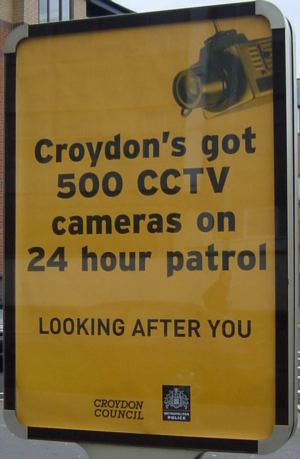
Of course, we all know power is in part transmitted by a sort of limitless capacity for suspicion that is shared by both the apparatus of security as well as those who are deemed its subjects – meaning, while power assumes everyone is a potential suspect it also functions on the subject’s own suspicion of the apparatus as being something potentially capable of an all-seeing, all-reaching respondent system for enforcing its jurisdiction beyond what is perceivable. Both power and subject of power rely on neither challenging the other, and therefore are bound in a strange kind of ongoing standoff, or a suspended moment of existential wait – a marriage of inaction – fundamentally paralyzed by their mutual uncertainty: that one will face perilous consequences, while the other will perhaps be exposed for its bombastic bluff of power.

[Image: The Penitentiary Panopticon or Inspection House, 1791 / © University College London Library, Bentham Papers 119a/120.]
It’s the essence of Bentham’s panopticon, I suppose, that power lives on the principle, as Foucault put it, “that it should be visible and unverifiable.” And because people are essentially predisposed to avoid fear it follows then that all power needs to do in order to expand its circuitry is to create an apparatus that induces a mere second of doubt in the mind of its subjects, to coerce that instinctive incapacitation that keeps them obedient, as they will then quickly move to avoid further confrontation with the unknown. The cognitive landscape there confounds me. What is the root of human aversion to fear? How long will we hide under our sheets from the boogeyman in the closet? Anyway, what better tool for the boogeyman now than our greater environment?
Again, to borrow from Foucault, the goal of power is to feature itself in such a way that it can assure ‘the automatic functioning and produce the homogeneous effects of power.’
it automatizes and disindividualizes power. […] Power has its principle not so much in a person as in a certain concerted distribution of bodies, surfaces, lights, gazes; in an arrangement whose internal mechanisms produce the relation in which individuals are caught up. […] A real subjection is born mechanically from a fictitious relation. So it is not necessary to use force to constrain. (source)
But, if this is the modern dictum of power’s conquest over space, then how long will the illusion work, and will the institution end up engineering a post-‘culture of fear’ frenzy of brazenly intrepid citizens and anarchist spatial hackers one day, seizing on the environment as a place to be continuously tested, violently more often then not? Aren’t we already kind of there anyway, or have we just always been? Isn’t this just part of the natural social friction that takes place in spaces engendered by institutional or colonial power? And the more the surveillance net extends itself, the greater the canvas for subversion becomes. If we consider the prison/panopticon scenario: how long would it take, I wonder, the inmates after not ever seeing an actual prison guard before deciding to test the surveillance efficacy of the panopticon? What would Plato’s prisoners in The Cave really do if they had the option of escaping? At what point does a citizenry begin to challenge the regime of spatial political power, or biopower that constitutes its urban reality? Or, its political system, for that matter? What are theoretically the conditions required for a revolution of spatial regime change; and how can space be subverted this way? How does space encode and enforce politics – the politics of fear – and how through space and urban intervention can the course of politics be renegotiated? If architecture represents a culture’s body of knowledge, a spatial archive of its histories and truths and an embodiment of its greater meaning, then what does all of this security space suggest about the west’s epistemological evolution? Or, devolution, as the case may be? If the city is the product of a society’s progress, a living museum of its growth in identity and humanity, what can be said for today’s “indefensible space
I don’t know, I’m obviously no theorist, and am not even really sure what I’m asking at this point, and there are likely a million precedents for answering such questions already, which all kind of lead me back to a more overarching philosophical question over the use of violence, and when (or under) what conditions it may ever be justified. I know good old Wild Bill Vollmann certainly has a lot to say on the subject, a question pitted at the core of humanity’s struggle, no doubt. But, it’s the architectural extension of that question that’s got me right now, and what the architect’s role, if any, may be in violent political upheaval – or, how architecture itself enacts violence, pacifies or circumnavigates it. More so, how can space be used as a tool for revolution? Or, how are political regimes cast in space, and how can the built environment be used to shift the gravity of power towards a politics of space that restores the democratic ideals of humanity’s best public urbanism, and what Henri Lefebvre wrote about as “the right to the city”?
Extracting Lebbeus Woods’ wisdom again, “Architecture, the very model of precision and self-exalting intelligence, should not fear its union with what has been the lowest form of human manifestation, the ugly evidence of violence. Architecture must learn to transform the violence, even as violence knows how to transform architecture.”
It’s something I’ll try to return to later as I get back to posting (sorry for the recent hiatus): the role of architecture – not just in political violence – but as a platform for redistributing power, systemic transformation, cultural uprising, overthrow, resiliency, regime change, counter culture and anarchist movements, both from the perspective of spatial practitioners and designers as well as a point of view that observes the ways space is used and can be reused for the same effect. Can architecture serve as a non-violent weapon for political revolution? Who knows, maybe that sounds like an absurd question.
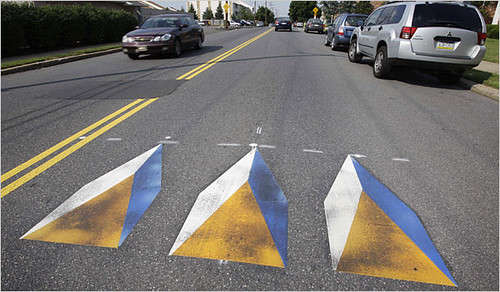
[Image: Optical illusions used as virtual speed humps / Telegraph, 2008.]
Anyway, wow – after all that. I want to point out these funky facades I spotted a while back that are being used in Philly, and before that Arizona (apparently in all seriousness) to help enforce some semblance of road safety via optical illusion, that got me thinking about all of this power-as-a-flat-impostor-of-itself stuff in the first place. Not a new concept by any stretch, but their artistry – if anything – might deserve a little attention here, more so than they were designed to attract, I’m sure.
Since they’re obviously meant to gain your attention long enough in so far as to quickly steer it towards obeying the speed limit, it’s funny then that these displays might actually produce the opposite effect once realized for the silly little farces they are – at which point, they make me kind of want to go check them out, up close and in detail, if just to appreciate their ability to have fooled me for a second.
These optically-faked speedbumps, or “virtual humps” as they are called, are actually pretty cool, I think, but seemingly would only work as long as it took someone to realize they didn’t actually exist, and that they are purely an illusionary tactic, which would be upon first encounter, I presume; unless you’re just some oblivious idiot, in which case you probably shouldn’t even be on the road in the first place. But perhaps that is precisely the point: not that people are idiots, necessarily, but that these virtual humps could actually succeed because people aren’t paying enough attention. It’s ironic, to say the least, then, that they’re success would rely in part on a driver’s lack of attention. And, similarly, a lot of the success of power (political or otherwise) is simply due to a failure to pay attention; a point I don’t think can ever be made enough. Though, you might also make the argument that these virtual humps would actually draw such attention that drivers would be distracted in order to examine them and potentially make themselves more dangerous or vulnerable to accidents. So, go figure.
Perhaps these faux-barriers kind of symbolize the shallow nature of a more broad proliferation of security features these days – or, non-features, I should say: I’m thinking about things like fake surveillance cams in store windows, random warning signs; or, you know, even those silly plastic chirping hawks that are situated on urban perches to help ward off pigeons that usually (from my vantage) get outwitted in a matter of days. Those stupid things just seem so symbolic. But such an object could even be the creation of a new position within the Dept. of Homeland Security, I suppose, or that silly colored terror threat level meter. I can’t help but to trip on how much useless junk is planted in the environment, on the peripheries of our attention span, that pretends to do some job, lord over us in some way, act as if we owe them for guarding something or protecting us, as if all this junk has a noble or civic purpose in life – when really all it’s doing is just squatting there and taking up space like a strewn empire of crap, and making you feel at any moment a tragedy or a horrible disaster is about to occur from around the corner.
Now, post 9/11, there is even more of this spectacular tinsel barricading to contend with. Homeland Security has completely matted our cities in defensive architectural product – and I’m tempted to call it all a “scarecrow urbanism” – designed less to prevent than to just ward off the foolish crows who would do the city harm. But “evil” is a bit more adept than that, I’m afraid, and you’d think the government would respect its enemy a little more by now. Not to mention, the psycho-authoritarian effects of the ubiquitous barricade on the city’s inhabitants, which may actually be more to the point of all this stuff.

[Image: Police unveil cardboard cops, Vancouver Sun, 2008.]
Check these dudes out. Love ‘em. Wuh’zupp occifers? Got get ‘em O’Malley!
Another favorite I came across are these life-sized mannequins of Taiwanese soldiers kickin’ it in a bunker. If there were any less action, we might even mistake the actual Korean soldiers who watch over the DMZ for mannequins themselves. It’s hilarious! I wonder how long these guys have been there – or if anyone ever tends to them. You know, cleans ‘em up bit, repositions their arms every now and then, gives them fake little cigs to puff on occasionally, or something. After all, these war puppets got a life to live, too!
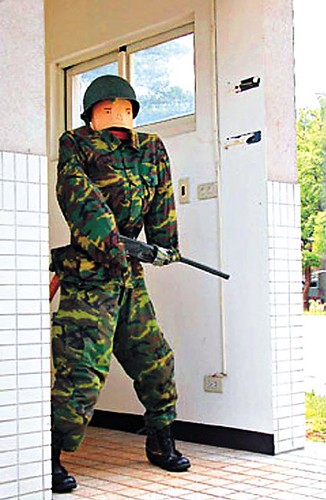
[Image: Guards Go Stiff at Local Army Base / Live Leak.]
Has to be one of the oldest strategies in the book, right? – the art of the military decoy. From the Sphynx to The Amazing Camouflage Deceptions of World War II, to those eerily disguised conspiracy dwellings and transformer houses Geoff wrote about a ways back. But these, I don’t know, are almost just pure comedy, like props from a tacky prank. So deliciously absurd compared to the more clever imbrications of security and design we see today blending landscape and public space (projects as far as I’m concerned are urban weapons made acceptable only by their aesthetics). When you think about the cloaking devices that researchers and other think tanks are developing – materials that may one day literally bend light around objects rendering them practically invisible – these cheap-ass little figurines are like precious future antiques from a very old world of military urbanism. I think I want one.
Of course, the Army’s brave new world of stealth engineering costs big bucks, and with the American military severely overburdened these days, and the speedbumps that have have finally burst the bubble of the American economy, perhaps these façade-works represent another cheaper security frontier lurking around tomorrow’s corner.
Actually, I’m surprised lenticular technology hasn’t been more harnessed beyond advertisements and such. I don’t know, maybe the technology isn’t half as advanced as I’d like to think it is, or nearly cheap enough to be deployed as any kind of believable projection of security objects that aren’t really there, not near anything capable of mimicking a kind of holographic fortress imaginary. But it’s not difficult to consider the incredible lenticular potential for architecture; buildings with extraspatial extensions that could jut out over the street when seen from a specific angle, hallucinatory bollards, barricades that emerge right in front of your eyes as you walk around certain buildings, open space cities that shift into fortified metropolises when glimpsed from a series of precise vantages; strolling through the farmers market could have far more deviant implications than first appear. From a militaristic perspective, surely there is a sinister mind out there plotting and planning the kinds of shifting projections that could stalk you from a place of non-reality, make a building seem much more secure than it really is, or even appear out of nowhere when it is not, or occupied when it is empty, etc. Making the enemy see things that aren’t really there, like urban mirages, phantasms of counter-insurgency, ghost-limbs of architectural defense, and so forth.
Back to the indebted future of the American economy, for a minute. It often seems the only thing that powers it is a titanic war machine bent on the business of perpetual conflict. Where would the U.S. be without its military economy? Will the military-industrial-complex eventually reach its own breaking point and grind to a halt one day, too? What is the forecast for American militarism around the world anyway and where will that leave the economy of “the greatest nation on earth” two hundred years from now?
Fast forward to a day when the war machine, by its own necessity, has had to drastically minimize production, having attempted to fulfill a hubris of being the globe’s single police force, it is now forced (for its own survival) to take a goliath step backwards as resources have grown dangerously scarce and hundreds of thousands of soldiers starve having been spread powerlessly thin around the world.
What if, one day the military arm of empire – in a last ditch effort to maintain its show of power – decides to change its strategy entirely and rely on an industrial complex of sophisticated 3D printers and Xerox machines instead, so that future armies of imperial conquest could be recalibrated using high-end papers, battle-tested inks, layered cross-sections of weather proof resins, that would slowly and secretly replace the active duties of real men? In other words, in its attempt to withdraw (without completely withdrawing), empire decides to launch a covert campaign to swap out from key locations its live bodied brigades with carefully placed life-sized posters, custom stand-ups, and mannequins of its toughest men the enemy has ever glimpsed. Could a marvelous militaristic façade do the same job in places, for example, where fighting is irregular and mostly the military is just used to occupy space along contentious borderozones, but for much cheaper, the Pentagon wonders? Old donated Hollywood animatronic puppets that have already fulfilled a life of heroic stardom onscreen suddenly start to serve their country in a stint of patriotism out in the real field. It’s ridiculous, of course, but picture some sort of rejuvenated Alf-gone-Rambo-like puppet out there in the jungles of Indonesia scarecrowing for its retirement.
Anyway, suppose, in this incredulously preposterous future, the balance of global political power somehow became weighed upon these incredible supplies of recycled papers, polymers and foams, and laser jet prints instead of military hardware? The recycling industry would grow insurmountably. Much of America’s suburban junk could be repurposed to form garbage-made men camped out on the frontlines. Instead of going to war, Uncle Johnny at home now could just upload a print out of himself in his most menacing pose and uniform and gain the same respect as any other war hero who fought for his country. It’s not a geopolitics of treatise or contested foreign policy anymore, but the strategic façade shenanigans of moving cut-out military grunts, armed dummies, billboard platoons, perforated recruits barely able to stand up to a good gust of wind, around the battlefield. It becomes a simple game of chess again. What if empire, in order to salvage itself, had to stoop to a world of cardboard-enforced occupation, counterfeit generals, look-a-like dictators, sign-post wars, and new terracotta armies cast from Styrofoam, in order to maintain its awesome projection of power?

And, even more strangely, what if during this massive transition war sort of became bored with itself and violence decided to just take a break, as if the empire’s reluctant demilitarization somehow led to a calm pacification of the battlefronts – imagine that!! What if it actually worked??? Cease fires seemed more popular, and the world of conflict became a frictionless cartography of useless border posts, absurdist standoffs, idle checkpoints, superfluous lines in the sand, while a few delirious soldiers are left to their posts like relics without official word of any war being over, or conflict having come to end. Empire toeing its line over a world held in check by a cheap trick installation of paper stormtroopers.
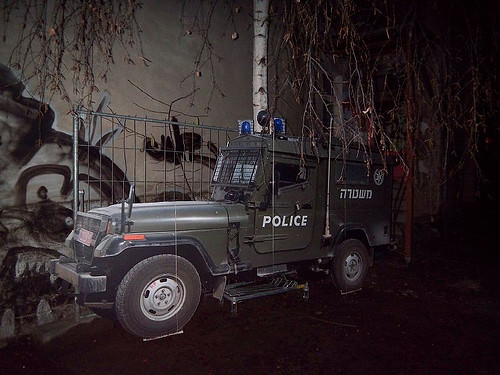
[Image: Hot Rod Border Facades, by Ronen, 2008.]
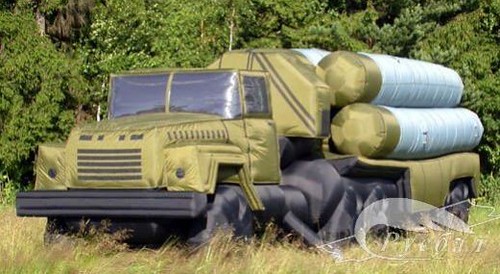
[Image: Russia Expands Inflatable Arsenal, Via Danger Room.]
So there you are one day woken in the same place you’ve awoken in the woods for months now, maybe years. You’ve been rattled from a long hibernation you’ve felt vaguely awake for the whole time, actually. Your overcoat has holes in its elbows and the Border Patrol patch on your arm is so worn it’s barely legible and just tears off when you scratch your lice infested beard. You can’t even recall the name of the area you’ve been stationed to anymore; your memory is dull, devoid of its usual referents – it’s a bunker lit by a dim flashlight and a few candles and it’s horribly inadequate at this point. The sounds of the woods have been the only thing that have mattered for a long time – you delight in them. In fact, you’ve literally developed these raspy feelers out of your head that let you appreciate the exceptional soundtrack of wherever the hell it is you are out there in the middle of nowhere on an insect level.
Roaming around the faded edges of your bunker where you’ve marked your territory thousands of times already, you wonder now if you are the last bastard on earth and if staying here is just your sorry ass fate, or what.
For more weeks than you can count you’ve lived off assorted bottled drinks, canned and powdered junk food dropped from a supply chopper every few days in the morning at sunrise with absolutely no communication from the pilots whatsoever, though their visits have been growing sparse, and this morning they did not show up again, and all you have to show for you life at this point is an barely conceivable mound of plastic and canned waste. You’re desperately emaciated, paper thin. You’ve just been doing your job as you were told ages ago, obediently watching over this notoriously dangerous and fertile migration zone, despite the fact you yourself have never seen a single soul attempt to trespass anywhere in the vicinity. You have all this time up until now been happy with that fact, but what you wouldn’t give just to here the footsteps of some stranger creeping through the woods at this point. You begin to think you’re leper, or have some catastrophically contagious disease. Your technology is dead and no one came to check on you.
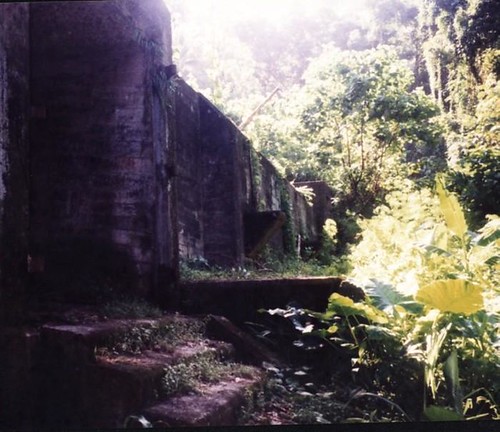
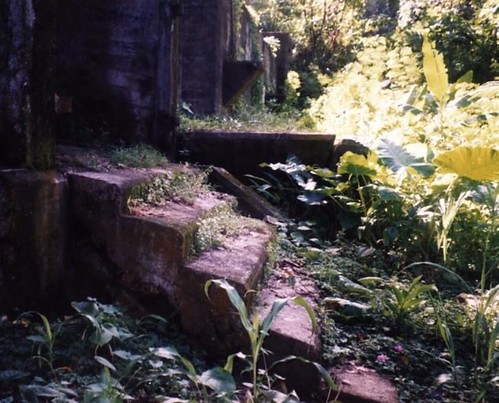
Everything around you is hideously overgrown as it should be, from the thickets and brush around your campsite to the dewy forest of your eyebrows and wild nose hairs. There is a wall of flora alongside the concrete buffs of your bunker, so high now it might be easy to just walk right past it without even noticing the rest of the mossed-over structure. Little deer, or some furry four legged mammals, love to come nibble on the scrumptious flower buds that have spawned by what once was a boggy entry into a nearby tunnel you were told only to enter as a last resort for escape. You pull out weeds, try to find its opening, but the hole cover can’t be found for the life of you. You doubt whether it even exists: were you really told about this, or was this your imagination all along? You know you are losing it, and fast.
Alone in these ridiculous trenches of occupational meaninglessness and servitude, you decide today’s the day to take a long hike back to the main checkpoint to get some scoop on what the hell the status of the conflict is, and whether you can finally just go home back to your precious monkey and your dog. Bumbling along old tangled paths that are barely visible anymore, the forest is as fresh and grown over as it has ever been, vibrant and green on some pre-human level. It’s wet, it stinks, your nose can’t get enough of it. You’re high and it feels great.
At first, there’s no sign of human settlement anywhere, no foul stench of war, not even so much a piece of trash or rusted gun shell, just nature flourishing perfectly in the morning sun by herself. You can see the tree limbs bending towards the light, rising in the heat, the ferns moving even though there is no breeze or critters in sight. Stupid to say, but it’s magic.

Along the way cutting through geometric panes of fallen light that dissects the woods, finally, you see the dark silhouettes of two soldiers just hanging out, idling once like you did as if frozen in time, forgotten, either on high alert, or stuck motionless taking the kinds of ceaseless pisses you take alone in the woods. You stop instantly, unsure if they are one of “us” or one of “them”. The silence and suspense of this ambiguity drives you backwards all the way to your bunker. There, you convince yourself they were scouts from the other side.
Somehow you sleep, then wake up again like you always do, stomach caving in on itself, and decide to venture back to the spot where you saw the two enemy soldiers hanging out. As soon as you get there, you spot them again, in the exact same position. It’s incredible, they haven’t moved at all. You get closer to identify them, and start to believe they’re the good guys.
You’re not sure if calling to them would blow their cover, endanger yourself, or what. But you’re thrilled just to see human life, even if they haven’t moved a bit since you spotted them the day before. So, you creep up on them, anxious to say hello but not get shot in the process. Since you haven’t really stalked anything real now for months your unpracticed foot busts a twig that sounds for miles, and you’re forced to stop dead in your tracks; and just like that, you’re back to being a lame-ass dummy of yourself squatting there in the woods with no one to hear you crap, because, they don’t budge. You even call to them, ‘Hey!’-- but still, they ignore you.
Moving closer you hear an odd material crackling and crunching under your boot. You kick some dirt aside (is it that damned tunnel entrance?) and find it’s actually one of them, flat on their back, staring up at you with a face half peeling off from itself. Finally, you discern that it’s a ridiculous print out of some jerk’s face plastered to a poster-thin cutout. He’s got binoculars. He’s eyeing you. WTF?
You walk over to the two shadows you were approaching only to find they, too, are strange posters of your comrades. One of them you even recognize as an old bunk mate! That jerk, where is he now?
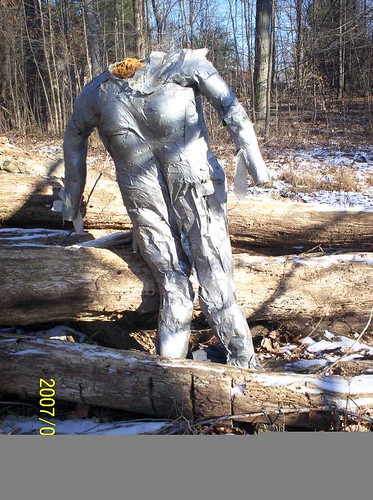
And this would be just the beginning. As you venture out further from your post en route to headquarters you would come to find the forest completely littered with these flimsy characters, fixed in stupid positions, aiming rifles at nothing, standing tall or hiding down low on one knee for no reason at all. Tons of them, guarding nothingness. They’re up in the trees, floating down a creek, huddled around what looks like an old campfire, some are even positioned to be having sex with each other, for christ’s sake. They’re just as proud when they’re snapped in two.


[Image: "Chicago" is an Israeli Defense Force urban warfare training facility in Israel, photographed by Adam Broomberg and Oliver Chanarin.]
Even more strange, there are a few dummies printed from the other side. Some guerrilla fighters, and other silly characters. Up until now you had no idea what the enemy really looked like. This one makes you chuckle.

You’re starved, delirious, but somehow not quite as alone as you once thought you were, or maybe you feel more alone than ever. But you try to gain confidence from these paper mercenaries knowing that someone must have situated them, and therefore real people must be nearby. You start racing through the woods into open meadows you think might be recognizable, but all around you are skittering squirrels and flat-faced mannequins brandishing folded gun barrels held by half-torn limbs. The closer you think you get to home the more target Tom, Dick and Harries you find staring back at you as if you were the enemy.
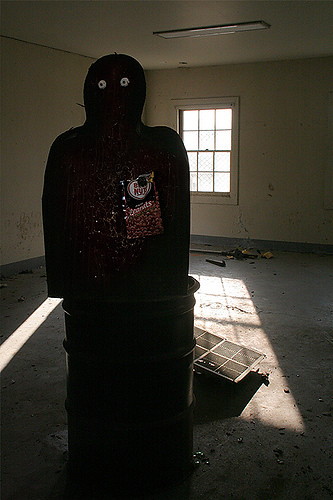
You're light on your feet and the forest is hunting you. You almost consider going back to your post to escape their relentless gaze, but it’s too late now. Is this some sort of training facility, you ask, mustering the last shreds of rationality your brittle brain can afford. Have you wandered into an outback Mecca of target practice, the periphery of some MOUT utopia? You haven’t heard any shots, nor do any of these spineless bastards have holes in their heads. Is this a joke; some kind of company hazing, or initiation? Is this is a test of your loyalty to your outpost? Will you suffer for abandoning it? Should you go back?
You wander the remains of this lost borderlands past graveyards of broken easels and windblown facades, following a slippery trail of fallen soldiers worn away like stickers in the rain, until miles later you finally exit the woods to find your old base camp devoid of everyone. It is now a feeble shell of a structure bombed out by the weather.
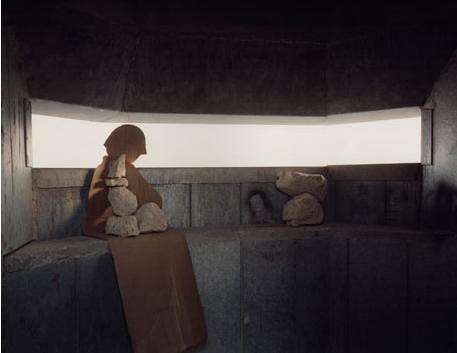
All you find left are piles of your old friends, delicate impostors of your superiors, laid flat, partially torched, folded, broken, stacked, half-assembled, unused – the whole thing looks like a vault full of stashed dummies, an abandoned storage unit for an undiscovered test site; it’s as if you’ve wandered into a military installation from a children’s pop-up story book that you can’t escape. There’s no one really there, just these grainy black and white apparitions of your old buddies scattered all over the place like a house of cards caught in the wind.

Walking around your foot slips into the ground. It’s the entrance to a secret tunnel. You climb down until you reach a floor. Awaiting you there is a faint figure. You strike a match and there you appear in two-dimensions crouching in the dark – a full-scale poster of yourself from a photo taken back when you first arrived. You were so gung ho then, so different. You’re aiming your machine gun straight at yourself now but no one can pull the trigger. The match catches the tip of the barrel and in a matter of seconds you start to burn.







6 Comments:
Nice to have you back to to the marathon posts...
It seems to me that guerrilla movements in Iraq and Afghanistan have already seen the scarecrow for what it is, knowing no matter how many more decoys we place, it makes no real difference. In the psychological race for power, we lost a long time ago. It really shows proponents of a "surge" in Afghanistan how pointless their endeavor will inevitably be.
back and in fine form indeed! hope this means you're feeling better.
Another brilliant post. CCTV, the Panopticon, dummy soldiers and racist shooting targets. I laughed, I thought, I had a good time. Thanks
the google translation of anonymous's comment:
Secretary of the Chinese breathing good network of skin cancer network China Network Chinese Cancer Rehabilitation Network document summing up the work of individual net sum up the work of summing up the work of six units in the year-end summary of the work of summing up the work of summing up the work of teachers in the teaching of summing up the work of moral education in schools summary of the work of summing up the work of the financial summary of the medical summary of the work safety Township summed up the work of summing up the work of Communist Youth League members sum up the work of summing up the work of summing up the work of the company work internship class sum up the work of summing up the work of summing up branch office summed up the work of student government work report summing up the report of honesty-reporting duty to report on his work report of the inspection report of the self-report of the investigation report of the report Survey report of the resignation of the report to apply for internship report of the inspection report of the assessment report on the work report on the thinking of the report?
brilliant post. still trying to digest the next 60% of it. the first 40% took me a long time already. it is never easy to find someone who can write eloquently on this matter. i think its vast and difficult to tie together all elements.
Tour de' force.
Post a Comment
<< Home